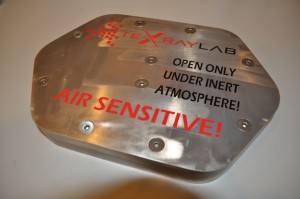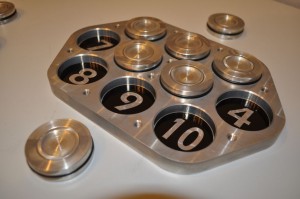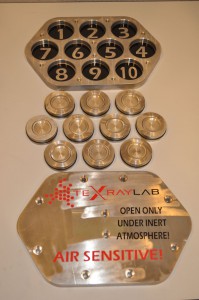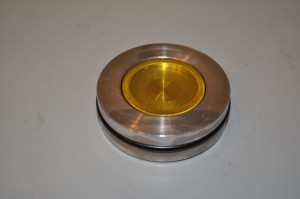Some months ago we had a pair of scientists visit our space to look over a refurbished Siemens D5000. Interestingly enough, they’d planned to use the system for some basic XRD, but mainly for the development of polycapillary optics. This is a fascinating new technology that’s gaining steam out in the R&D centers around the world and merits a full post dedicated to it ASAP. This is the type of “game changing” innovation which hasn’t come along in XRD in decades. They took delivery of their machine a few weeks ago, but while on-site they asked about another project. All that’s really needed is simple phase analysis by XRD with one complication, the material reacts violently when exposed to air.
We roughed out a basic design the same day, but that was only the beginning. Dealing with materials like this necessitates careful consideration of all material and procedures involved in getting it from the lab where it’s synthesized to ours and back. The final design involved billet Aluminum, BUNA rubber o-rings and polyimide (Kapton) film and took quite a while to flesh out. The end result is a complete system which allows the customer to load the samples into individual cells inside their own glove box. The individual cells can be loaded into the case inside the glove box as well. The outer o-rings on the cells seal against chamfered edges on the pockets of the case creating a second sealed area above and below the sample. It’s unlikely that the inner cell would ever rupture, but this protects the polyimide film and adds a substantial extra level of safety.

This is the complete case as it will ship. The flat-head bolts hold everything together and provide the necessary force to seal the chambers.

With the case open, you can see the individual cells along with the top and bottom of the case. The labeling shouldn’t be necessary since there are strict protocols in place for transportation of this material, but it never hurts to be cautious.

The original design called for a slightly more secure seal, but when we started working up the procedure to assemble them, it became clear that something simpler was needed, particularly considering that these will be loaded in a glove-box. An 11th hour rehash necessitated new o-rings, modification of the outer cell rings and complete redesign and fabrication of the cell center sections. I think this was well worth the effort though as they’re much easier to assemble now. There’s even a nice little tool to make it easier to open them back up for disposal or reloading. The original design would have been essential disposable.

